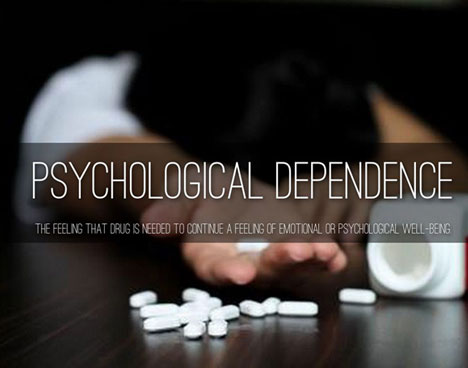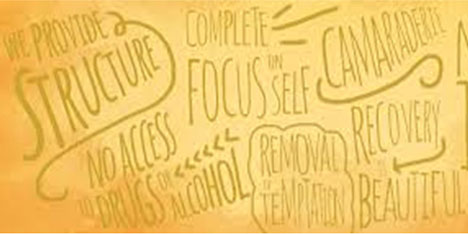Other Addictions
Drug rehabilitation

Drug rehabilitation (often drug rehab or just rehab) is a term for the processes of medical or psychotherapeutic treatment, for dependency on psychoactive substances such as alcohol, prescription drugs, and street drugs such as cocaine, heroin or amphetamines. The general intent is to enable the patient to confront substance dependence, if present, and cease substance abuse in order to avoid the psychological, legal, financial, social, and physical consequences that can be caused, especially by extreme abuse. Treatment includes medication for depression or other disorders, counseling by experts and sharing of experience with other addicts. Some rehab centers include motion and spiritual wisdom in the treatment process. A few centers also treat gambling with the same techniques as are used in drug rehabilitation.
Psychological dependency

Psychological dependency is addressed in many drug rehabilitation programs by attempting to teach the patient new methods of interacting in a drug-free environment. In particular, patients are generally encouraged, or possibly even required, to not associate with friends who still use the addictive substance. Twelve-step programs encourage addicts not only to stop using alcohol or other drugs, but to examine and change habits related to their addictions. Many programs emphasize that recovery is a permanent process without culmination. For legal drugs such as alcohol, complete abstention—rather than attempts at moderation, which may lead to relapse—is also emphasized ("One is too many, and a thousand is never enough.") Whether moderation is achievable by those with a history of abuse remains a controversial point, but is generally considered unsustainable.
Types of treatment

Various types of programs offer help in drug rehabilitation, including: residential treatment (in-patient), out-patient, local support groups, extended care centers, recovery or sober houses, addiction counselling, mental health, and medical care. Some rehab centers offer age- and gender-specific programs. In a survey of treatment providers from three separate institutions (the National Association of Alcoholism and Drug Abuse Counselors, Rational Recovery Systems and the Society of Psychologists in Addictive Behaviors) measuring the treatment provider's responses on the Spiritual Belief Scale (a scale measuring belief in the four spiritual characteristics AA identified by Ernest Kurtz); the scores were found to explain 41% of the variance in the treatment provider's responses on the Addiction Belief Scale (a scale measuring adherence to the disease model or the free-will model addiction).
Scientific research since 1970 shows that effective treatment addresses the multiple needs of the patient rather than treating addiction alone.citation needed In addition, medically assisted drug detoxification or alcohol detoxification alone is ineffective as a treatment for addiction.citation needed The National Institute on Drug Abuse (NIDA) recommends detoxification followed by both medication (where applicable) and behavioral therapy, followed by relapse prevention. According to NIDA, effective treatment must address medical and mental health services as well as follow-up options, such as community or family based recovery support systems.4 Whatever the methodology, patient motivation is an important factor in treatment success.
For individuals addicted to prescription drugs, treatments tend to be similar to those who are addicted to drugs affecting the same brain systems. Medication like methadone and buprenorphine can be used to treat addiction to prescription opiates, and behavioral therapies can be used to treat addiction to prescription stimulants, benzodiazepines, and other drugs.
Types of behavioral therapy include:

- Cognitive-behavioral therapy, which seeks to help patients to recognize, avoid and cope with situations in which they are most likely to relapse.
- Multidimensional family therapy, which is designed to support recovery of the patient by improving family functioning.
- Motivational interviewing, which is designed to increase patient motivation to change behavior and enter treatment.
- Motivational incentives, which uses positive reinforcement to encourage abstinence from the addictive substance.
Medications:

Certain opioid medications such as methadone and more recently buprenorphine (In America, "Subutex" and "Suboxone") are widely used to treat addiction and dependence on other opioids such as heroin, morphine or oxycodone. Methadone and buprenorphine are maintenance therapies intended to reduce cravings for opiates, thereby reducing illegal drug use, and the risks associated with it, such as disease, arrest, incarceration, and death, in line with the philosophy of harm reduction. Both drugs may be used as maintenance medications (taken for an indefinite period of time), or used as detoxification aids.8 All available studies collected in the 2005 Australian National Evaluation of Pharmacotherapies for Opioid Dependence suggest that maintenance treatment is preferable,8 with very high rates (79–100%)8 of relapse within three months of detoxification from LAAM, buprenorphine, and methadone.
Ibogaine is a hallucinogenic drug promoted by certain fringe groups to interrupt both physical dependence and psychological craving to a broad range or drugs including narcotics, stimulants, alcohol and nicotine.
To date, there have never been any controlled studies showing it to be effective, and it is accepted as a treatment by no association of physicians, pharmacists, or addictionologists. There have been several deaths related to ibogaine use, which causes tachycardia and long QT syndrome. The drug is an illegal Schedule I controlled substance in the United States, and the foreign facilities in which it is administered tend to have little oversight, and range from motel rooms to one moderately-sized rehabilitation center. Some antidepressants also show usefulness in moderating drug use, particularly to nicotine, and it has become common for researchers to re-examine already approved drugs for new uses in drug rehabilitation.
According to the National Institute on Drug Abuse (NIDA), patients stabilized on adequate, sustained doses of methadone or buprenorphine can keep their jobs, avoid crime and violence, and reduce their exposure to HIV and Hepatitis C by stopping or reducing injection drug use and drug-related high risk sexual behavior. Naltrexone is a long-acting opioid antagonist with few side effects. It is usually prescribed in outpatient medical conditions. Naltrexone blocks the euphoric effects of alcohol and opiates. Naltrexone cuts relapse risk during the first 3 months by about 36%. However, it is far less effective in helping patients maintain abstinence or retaining them in the drug-treatment system (retention rates average 12% at 90 days for naltrexone, average 57% at 90 days for buprenorphine, average 61% at 90 days for methadone).
Acamprosate, disulfiram & topiramate a novel anticonvulsant sulphonated sugar are also used to treat alcohol addiction. Acamprosate has shown effectiveness for patients with severe dependence, helping them to maintain abstinence for several weeks or months. Disulfiram (also called Antabuse) produces a very unpleasant reaction when drinking alcohol that includes flushing, nausea and palpitations. It is more effective for patients with high motivation and some addicts use it only for high risk situations.
Nitrous oxide has been shown to be an effective treatment for a number of addictions.
Residential treatment

In-patient residential treatment for alcohol abuse is expensive and common in the U.S. Most American programs follow a traditional 28-day program length. The length is based solely upon providers' experience in the 1940s that clients needed about one week to get over the physical changes, another week to understand the program, and another week or two to become stable.15 Seventy to 80 percent of American residential alcohol treatment programs provide 12-step therapy.
Experimental treatment
The Nature of Things, a CBC Television program by David Suzuki, explored an experimental drug treatment by Dr. Gabor Maté who works with addicts in Vancouver which uses the substance Ayahuasca.